Home » Archives for February 2013
Kid hides in locker, tapes teacher
Posted by Unknown
Racy mag cover features Kim, Kanye
Posted by Unknown
Suspect in Las Vegas shooting, crash apprehended
Posted by Unknown
(CNN) -- One week after an all-too-real scene befitting a movie played out on the famed Las Vegas Strip -- a pre-dawn shooting that sparked a deadly, fiery crash -- the man authorities suspect started it all is finally under arrest.
Ammar Asim Faruq Harris, 26, was apprehended around noon (3 p.m. ET) on Thursday in North Hollywood, California, said FBI spokeswoman Lourdes Arocho.
FBI agents and members of the Los Angeles Police Department's Fugitive Task Force made the arrest, according to Arocho.
Harris was detained "without incident" in the Los Angeles neighborhood and will be held pending extradition proceedings, Las Vegas police said in a news release.
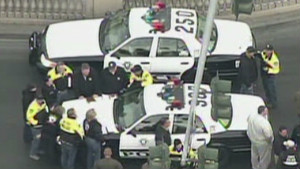 Three dead after shooting in Las Vegas
Three dead after shooting in Las Vegas This all went down 275 miles southwest from where, authorities say, Harris was at the wheel of a black Range Rover around 4:20 a.m. last Thursday when he allegedly opened fire on a Maserati driven by Kenneth Cherry, an aspiring rapper known as Kenny Clutch, as it headed north on Las Vegas Boulevard.
Cherry was shot in the chest and arm. His vehicle collided with a taxi, which caught fire.
The crash killed cab driver Michael Boldon and a passenger, Washington state resident Sandra Sutton-Wasmund. The 27-year-old Cherry later died at a hospital.
The Las Vegas Metropolitan Police Department identified Harris as the shooting suspect on Saturday, at which time they said his vehicle had been impounded. He had an "extensive and violent criminal history" and was considered armed and dangerous, according to police.
Las Vegas Strip shooting suspect named, car impounded
The whole scene played out in the midst of the Las Vegas tourist hub, closing a block and a half of the well-known boulevard near some of the Nevada city's biggest draws -- Caesars Palace, the Bellagio, Bally's and the Flamingo.
Seventeen years earlier, legendary rapper Tupac Shakur was shot dead two blocks from the accident scene.
On Tuesday, police said they looking for a woman in connection with the latest shooting, adding that she was believed to be inside the Range Rover when the shots were fired.
At the time, they characterized her as missing and possibly endangered.
The photos they released, however, showed the wrong woman. Earlier Thursday, Las Vegas police said they no longer considered the woman -- identified as Yenesis Alfonso, also known as Tineesha Howard -- "a missing person or a person of interest."
Las Vegas police issue wrong photographs of 'person of interest'
House OKs Senate's Violence Against Women Act
Posted by Unknown
Washington (CNN) -- Struggling again with an issue important to women and minority groups, House Republicans on Thursday failed to pass their version of a new Violence Against Women Act and then split over a Senate version that won approval with unanimous Democratic support.
The measure now goes to President Barack Obama, who said in a statement that it was "an important step towards making sure no one in America is forced to live in fear."
"I look forward to signing it into law as soon as it hits my desk," Obama said.
TIME photos: A portrait of domestic violence
Thursday's votes reflected an emerging political reality in the GOP-led House, with a minority of Republicans joining Democrats to pass legislation supported by the public, including increasingly influential demographics such as Hispanic Americans.
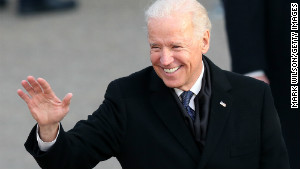 Obama: Good job, Joe
Obama: Good job, Joe By a vote of 166-257, the GOP version of the Violence Against Women Act failed to win a majority after almost 90 minutes of debate. The House then voted 286-138 to pass the Senate version, with 87 Republicans joining all 199 Democrats to provide majority support.
Originally passed in 1994 and reauthorized since, the act provides support for organizations that serve domestic violence victims. Criminal prosecutions of abusers are generally the responsibility of local authorities, but the act stiffened sentences for stalking under federal law.
Supporters credit the act with sharply reducing the number of lives lost to domestic violence over the past two decades.
Last year, the House and Senate were unable to compromise on another extension of the act, with Republicans opposing Democratic attempts to specify inclusion of native Americans, undocumented immigrants and lesbian, transgender and bisexual women.
Opinion: The plague of violence against women
However, exit polling showed Obama won strong support among women and Latino voters in the November election that also strengthened the Democratic majority in the Senate and weakened the Republican majority in the House.
Republicans then changed their stance and agreed to bring up the measure in the new Congress as long as they could offer their own version.
The Republican proposal deleted provisions from the Senate measure giving tribal authorities jurisdiction to prosecute cases on Indian reservations, specifically against discrimination of LGBT victims, and allowing undocumented immigrant survivors of domestic violence to seek legal status.
In debate before Thursday's votes, Rep. Kevin Cramer, R-North Dakota, said the Senate version includes legal precedents of expanded sovereignty that could be subject to court challenge.
Opinion: Rubio missed the year of the woman
"Please consider the damage we have done if a court overturns this act and its protection all because we wanted a good slogan instead of a good law," Cramer said.
House Democratic Leader Nancy Pelosi of California and others repeatedly questioned why Republicans would seek to weaken a measure that received strong bipartisan support in the Senate.
A majority of Senate Republicans backed the act, along with every woman senator regardless of party, Pelosi noted.
"It's really hard to explain why, what eyes the Republicans are looking through, that they do not see the folly of their ways in the legislation they are proposing," Pelosi said.
Democratic Rep. Gwen Moore of Wisconsin, herself a rape victim, paraphrased the question of rights activist Sojourner Truth, a 19th century escaped slave and civil rights advocate.
"Ain't they women?" Moore shouted in reference to native American, undocumented immigrant and LGBT women.
In response, Republican Rep. Cathy McMorris Rodgers of Washington challenged Democratic claims that the GOP version excluded any women, saying it was all-inclusive.
A global push to end violence with song and dance
House Majority Leader Eric Cantor of Virginia said the goal was to "make sure all women are safe," and he described the Republican version as an attempt to "improve on" what the Senate sent over.
However, Pelosi noted that hundreds of advocacy groups supported the Senate version as the best way forward.
"This is a remarkable day because we have clarity between the two proposals," she said, noting one had support from both parties in the Senate and the president while the other was opposed by "almost everybody who has anything to do with the issue of violence against women."
The final vote on Thursday followed the same pattern as votes on other legislation at the end of the previous Congress, including the agreement to avoid some impacts of the fiscal cliff at the beginning of the year.
A divide between conservative and more moderate Republicans prevented House GOP leaders from being able to pass their proposed legislation.
In the end, public pressure ratcheted up by Obama led to approval of a Democratic-inspired proposal that raised taxes on the nation's top income earners, a key campaign theme in the November election.
It passed with backing from most or all Democrats and dozens of Republicans.
Such a dynamic signals continuing inability of House Speaker John Boehner to marshal his GOP members on some of the most contentious issues coming up, such as deficit reduction and immigration reform.
Boehner risks his standing as a party leader if he continues conceding on measures that become law without majority support from House Republicans, which also would fuel continuing unrest by conservatives who traditionally comprise the GOP base.
Domestic violence bill vote critical test of more inclusive GOP
According to advocacy groups, the Senate version of the Violence Against Women Act strengthens protections of particular groups of women at particular risk.
For example, one in three native women will be raped in their lifetime, according to the Indian Law Resource Center. Three in five will be physically assaulted, and native women also are killed at a rate 10 times the national average, the center said.
The National Congress of American Indians addressed the issue in a December 20 letter to Cantor.
It described situations in which beatings and rapes by non-native men were declined for prosecution at a federal level and returned to a tribal court as a misdemeanor.
Federal law currently prohibits tribal courts from imposing a jail sentence of more than a year, so they generally do not prosecute felonies. In many instances, such cases are dismissed altogether and a defendant can walk free until a grand jury indictment can be obtained.
"The federal criminal justice system is simply not equipped to handle local crimes, and this is the primary reason that tribes seek local control over these crimes that are plaguing our communities," the letter said.
On undocumented immigrants, Human Rights Watch has found that immigrant farm workers are especially at risk for domestic abuse and argued provisions in the Senate bill "would go some way toward fixing the problem."
Those in the LGBT community are another high-risk group that will be affected by the Violence Against Women Act.
They experience violence at the same rate as heterosexuals but are less likely to report it. When they do, many are denied services.
About 45% of LGBT victims were turned away when they sought help from a domestic violence shelter and nearly 55% of those who sought protection orders were denied them, according to the National Task Force to End Sexual and Domestic Violence Against Women.
Opinion: GOP House's inaction on VAWA shows bigotry
Journalist: Threat was very clear
Posted by Unknown
Electing a pope
Posted by Unknown
(CNN) -- With Pope Benedict XVI leaving the papal office after resigning two weeks ago, the Catholic Church will have to rush to pick his replacement before Easter.
Normally, the College of Cardinals is not allowed to select a new pontiff until 15 to 20 days after the office becomes vacant -- usually when the previous pope has died.
Benedict's resignation is a rare exception. The last man to quit the head of the Catholic Church did so 600 years ago.
The situation calls for some rule bending, and having the current pope involved is proving advantageous.
Interactive: Where does the pope live?
.cnnArticleGalleryNav{border:1px solid #000;cursor:pointer;float:left;height:25px;text-align:center;width:25px} .cnnArticleGalleryNavOn{background-color:#C03;border:1px solid #000;float:left;height:25px;text-align:center;width:20px} .cnnArticleGalleryNavDisabled{background-color:#222;border:1px solid #000;color:#666;float:left;height:25px;text-align:center;width:25px} .cnnArticleExpandableTarget{background-color:#000;display:none;position:absolute} .cnnArticlePhotoContainer{height:122px;width:214px} .cnnArticleBoxImage{cursor:pointer;height:122px;padding-top:0;width:214px} .cnnArticleGalleryCaptionControl{background-color:#000;color:#FFF} .cnnArticleGalleryCaptionControlText{cursor:pointer;float:right;font-size:10px;padding:3px 10px 3px 3px} .cnnArticleGalleryPhotoContainer cite{background:none repeat scroll 0 0 #000;bottom:48px;color:#FFF;height:auto;left:420px;opacity:.7;position:absolute;width:200px;padding:10px} .cnnArticleGalleryClose{background-color:#fff;display:block;text-align:right} .cnnArticleGalleryCloseButton{cursor:pointer} .cnnArticleGalleryNavPrevNext span{background-color:#444;color:#CCC;cursor:pointer;float:left;height:23px;text-align:center;width:26px;padding:4px 0 0} .cnnArticleGalleryNavPrevNextDisabled span{background-color:#444;color:#666;float:left;height:23px;text-align:center;width:25px;padding:4px 0 0} .cnnVerticalGalleryPhoto{padding-right:68px;width:270px;margin:0 auto} .cnnGalleryContainer{float:left;clear:left;margin:0 0 20px;padding:0 0 0 10px}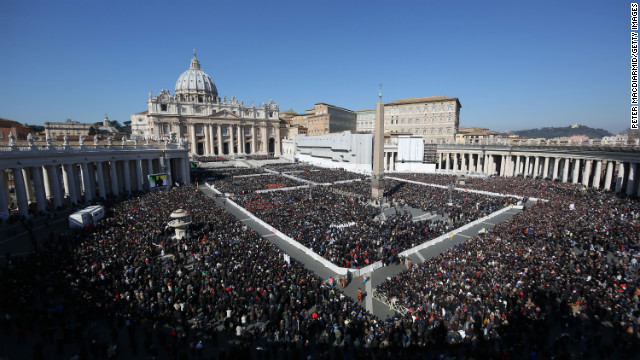 The faithful fill St. Peter's Square as Pope Benedict XVI attends his last public audience on Wednesday, February 27, in Vatican City. Benedict's decision to resign earlier this month caught a lot of Vatican watchers, apparently even some in his inner circle, off-guard.
The faithful fill St. Peter's Square as Pope Benedict XVI attends his last public audience on Wednesday, February 27, in Vatican City. Benedict's decision to resign earlier this month caught a lot of Vatican watchers, apparently even some in his inner circle, off-guard.  The pope delivers his blessing. Benedict recounted how when he was asked to be pope eight years ago, he had prayed for God's guidance and had felt his presence "every day" since.
The pope delivers his blessing. Benedict recounted how when he was asked to be pope eight years ago, he had prayed for God's guidance and had felt his presence "every day" since. 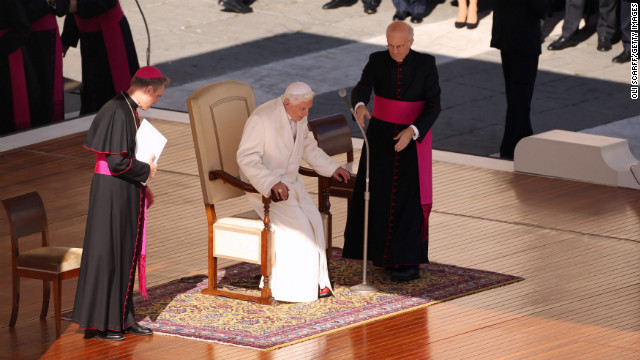 Benedict takes his seat on the dias in St. Peter's Square. In an unusually personal message, he said there had been "many days of sunshine" but also "times when the water was rough ... and the Lord seemed to sleep."
Benedict takes his seat on the dias in St. Peter's Square. In an unusually personal message, he said there had been "many days of sunshine" but also "times when the water was rough ... and the Lord seemed to sleep." 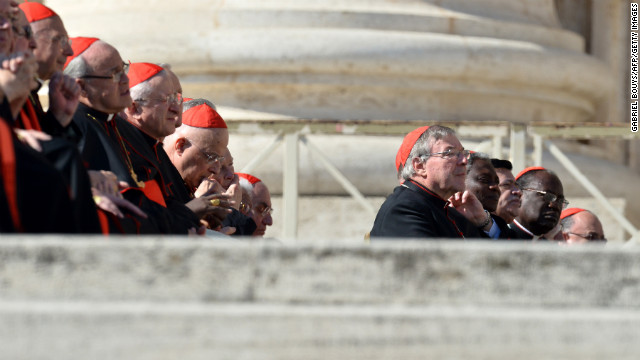 Cardinals listen to the pope.
Cardinals listen to the pope. 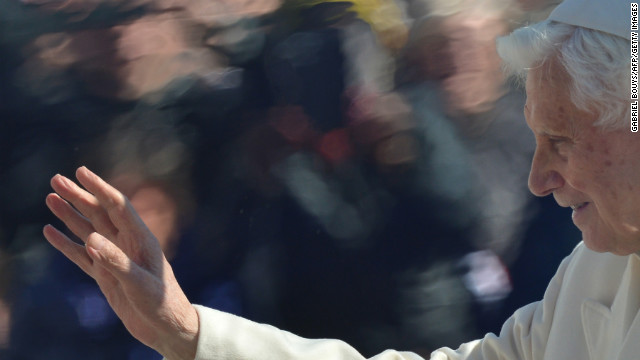 The pope waves to the crowd.
The pope waves to the crowd. 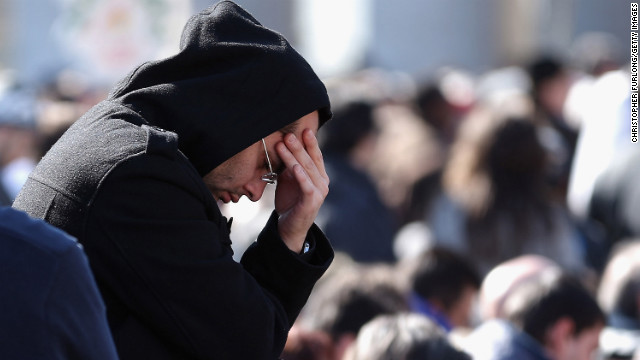 A pilgrim prays as he attends Benedict's final general audience address.
A pilgrim prays as he attends Benedict's final general audience address. 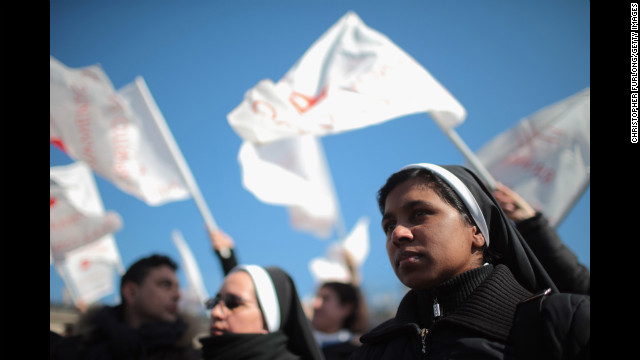 Nuns attend the address.
Nuns attend the address.  Archbishops and cardinals sit in St. Peter's Square. The pope used his last general audience to call for a renewal of faith and speak of his own spiritual journey through eight years as leader of the world's 1.2 billion Catholics.
Archbishops and cardinals sit in St. Peter's Square. The pope used his last general audience to call for a renewal of faith and speak of his own spiritual journey through eight years as leader of the world's 1.2 billion Catholics. 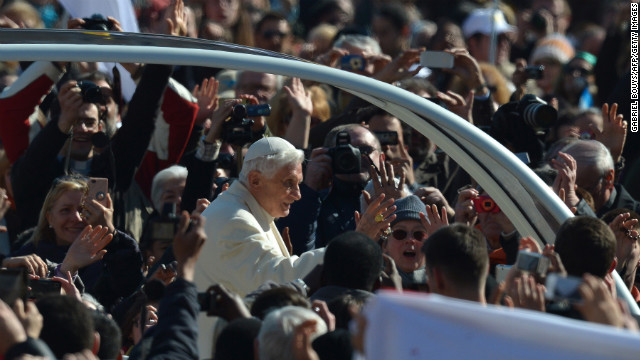 Benedict waves from to the crowd as he arrives at St. Peter's Square.
Benedict waves from to the crowd as he arrives at St. Peter's Square.  The pope kisses a child as he arrives.
The pope kisses a child as he arrives. 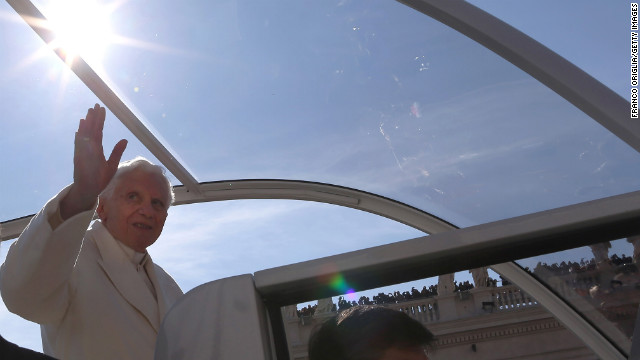 Benedict waves to the faithful. "Loving the church also means having the courage to make tough choices," he said, as he called on the faithful to pray for him and the new pope.
Benedict waves to the faithful. "Loving the church also means having the courage to make tough choices," he said, as he called on the faithful to pray for him and the new pope. 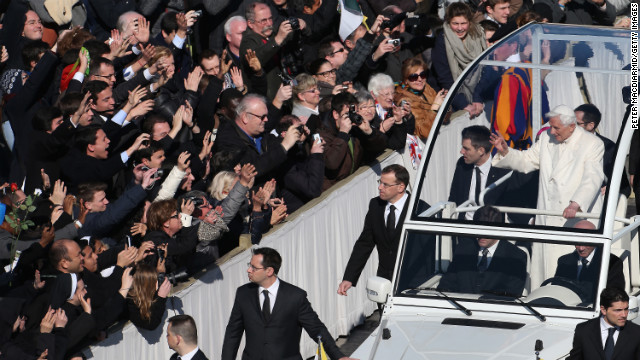 Benedict waves to the crowd as he arrives in the popemobile.
Benedict waves to the crowd as he arrives in the popemobile. 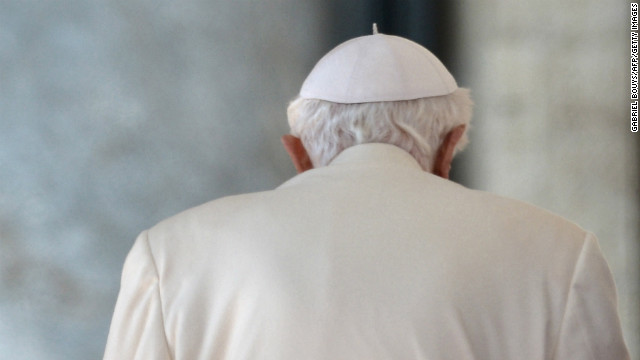 Benedict leaves the altar at the end of his last weekly audience.
Benedict leaves the altar at the end of his last weekly audience. 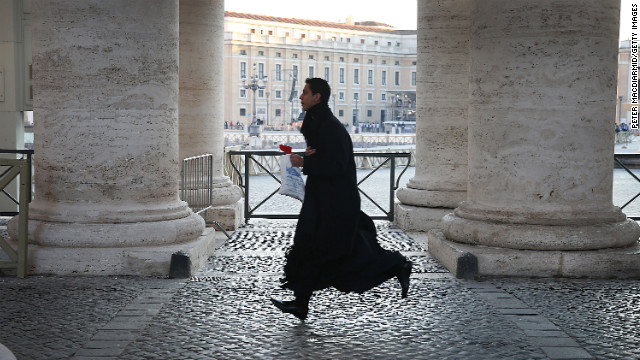 A priest runs to get into St. Peter's Square ahead of pope's last public audience address.
A priest runs to get into St. Peter's Square ahead of pope's last public audience address. 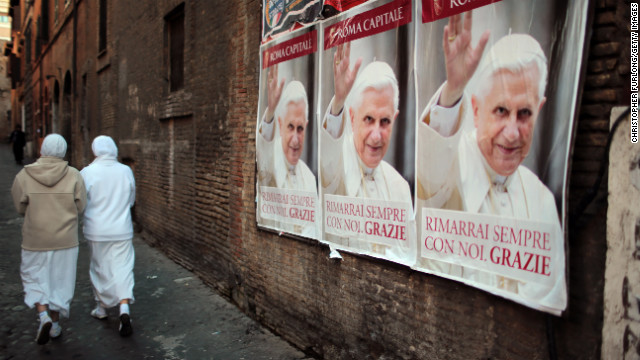 Two nuns leave Vatican City after the pope's address. Among the crowds were groups of pilgrims who had traveled to Rome for the special occasion, as well as locals and curious visitors keen to share in the moment.
Two nuns leave Vatican City after the pope's address. Among the crowds were groups of pilgrims who had traveled to Rome for the special occasion, as well as locals and curious visitors keen to share in the moment. 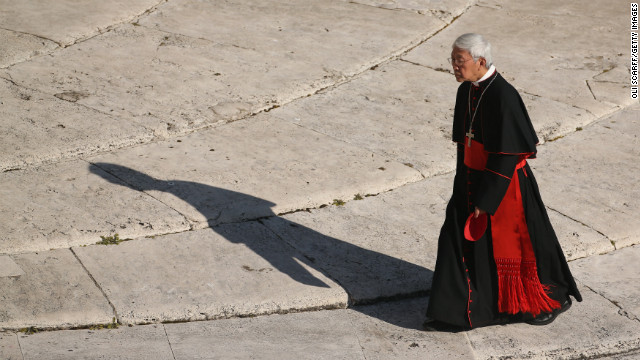 A cardinal arrives in St. Peter's Square. Benedict will leave office at 8 p.m. local time Thursday.
A cardinal arrives in St. Peter's Square. Benedict will leave office at 8 p.m. local time Thursday. 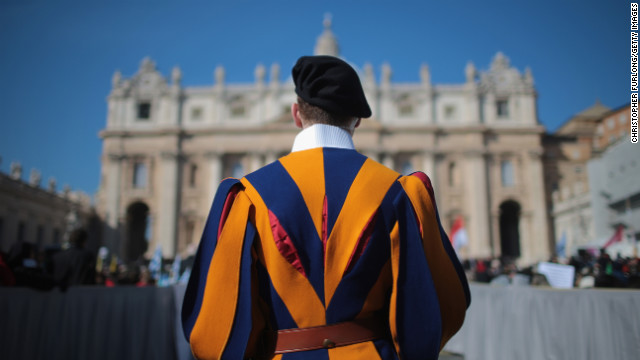 A Swiss guard stands in front of the Vatican. Benedict XVI's final papal audience Benedict's final papal audience Benedict XVI's final papal audience Benedict XVI's final papal audience Benedict XVI's final papal audience Benedict XVI's final papal audience Benedict XVI's final papal audience Benedict XVI's final papal audience Benedict XVI's final papal audience Benedict XVI's final papal audience Benedict XVI's final papal audience Benedict XVI's final papal audience Benedict XVI's final papal audience Benedict XVI's final papal audience Benedict XVI's final papal audience Benedict XVI's final papal audience Benedict XVI's final papal audience HIDE CAPTION << <
A Swiss guard stands in front of the Vatican. Benedict XVI's final papal audience Benedict's final papal audience Benedict XVI's final papal audience Benedict XVI's final papal audience Benedict XVI's final papal audience Benedict XVI's final papal audience Benedict XVI's final papal audience Benedict XVI's final papal audience Benedict XVI's final papal audience Benedict XVI's final papal audience Benedict XVI's final papal audience Benedict XVI's final papal audience Benedict XVI's final papal audience Benedict XVI's final papal audience Benedict XVI's final papal audience Benedict XVI's final papal audience Benedict XVI's final papal audience HIDE CAPTION << <  1
1  2
2  3
3  4
4  5
5  6
6  7
7  8
8  9
9  10
10  11
11  12
12  13
13  14
14  15
15  16
16  17 > >>
17 > >>  Benedict's final papal audience
Benedict's final papal audience 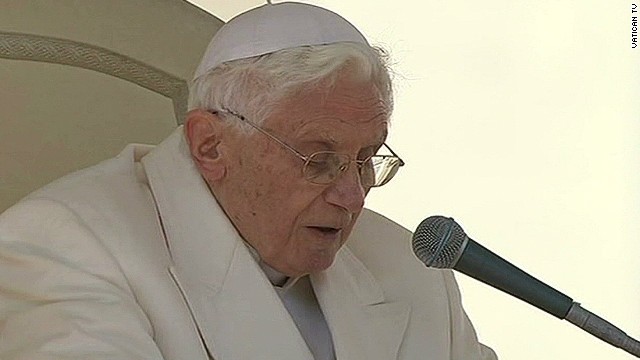 Pope: 'My strength had decreased'
Pope: 'My strength had decreased'  Pope: 'Deeply grateful for prayers'
Pope: 'Deeply grateful for prayers' 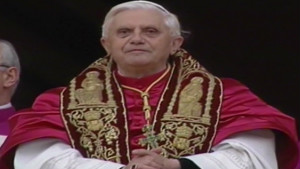 The pope says farewell to faithful
The pope says farewell to faithful 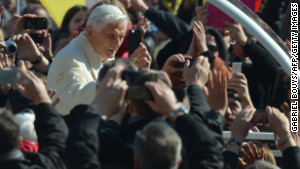 Pope Benedict arrives for final audience
Pope Benedict arrives for final audience He has slightly amended the 500-year-old policy on pope selection to get a successor into place more rapidly.
The cardinals may to be able to pull it off before March 15, according to Vatican spokesman, Father Federico Lombardi.
This would give the new pontiff a little over a week to prepare for the next mass, Palm Sunday celebrations, on March 24.
While Benedict won't be directly involved in his successor's selection, his influence will undoubtedly be felt. He appointed 67 of at least 115 cardinals set to make the decision.
The pope gives his last audience Wednesday morning. His last day on the job is Thursday.
Here's a look at the process of electing a new pope:
What has to happen first?
There were traditionally three methods of choosing a new pope, but the church abolished two -- leaving cardinals to pick a peer via paper ballot only.
When a pope dies, the dean of the Sacred College of Cardinals calls for a meeting of all cardinals eligible to vote -- those under age 80.
They have to vote in person. Although some work at the Vatican, most are spread out worldwide running dioceses or archdioceses, and will have to travel to Rome.
Once they get there, they can't leave until the process is done and aren't allowed to talk with anyone outside of the conclave.
Though Benedict left the rules greatly untouched, experts on the Church's constitution will comb through the section on the "Vacancy of the Apostolic See and the Election of the Roman Pontiff" (how to elect a new pope when the office is vacant) and interpret proper protocol for the election.
Benedict's predecessor, the widely popular John Paul II, made a number of changes to the voting process in 1996 to make it less taxing on the cardinals.
Opinion: How next pope must tackle child sex abuse
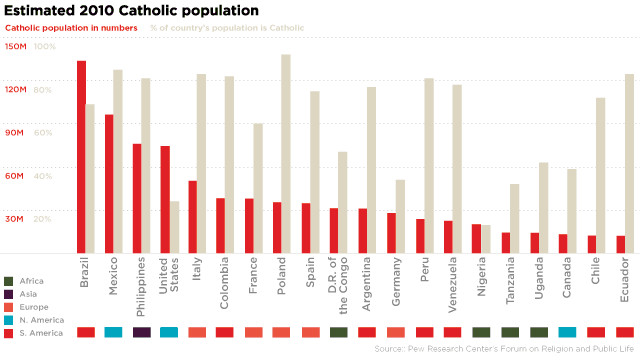 Catholic population in numbers
Catholic population in numbers  Catholic population in numbers
Catholic population in numbers  Catholic population in numbers
Catholic population in numbers  Catholic population in numbers
Catholic population in numbers 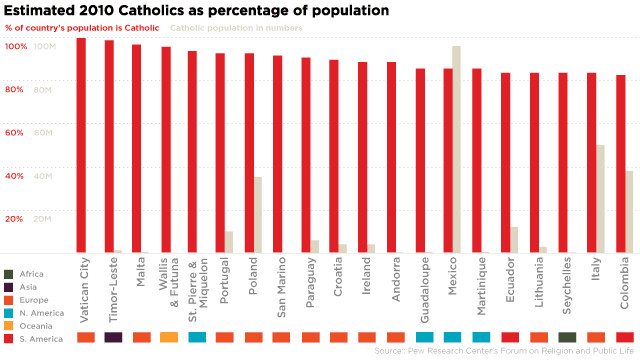 Catholic population in percentages
Catholic population in percentages  Catholic population in percentages
Catholic population in percentages  Catholic population in percentages
Catholic population in percentages  Catholic population in percentages
Catholic population in percentages Will the world get to see the process?
Although the procedure is transparent to participating cardinals, no one else is supposed to find out about the vote.
In his amendments to voting procedures in 1996, John Paul II anticipated modern forms of communication and forbade any recording devices. He ordered that technicians check the Sistine Chapel for hidden microphones or cameras before the balloting begins.
The new pope would be called to deal with violators personally.
"They will be subject to grave penalties according to the judgment of the future pope," the former pontiff wrote.
Notes cardinals make during the voting must be burned with the ballots.
The final declaration of a winner is sealed in an envelope and archived. It may only be opened by order of the pope.
The pope in retirement: What to expect
What does balloting look like?
The meeting of cardinals, called the conclave, usually begins with a special morning mass in St. Peter's Basilica. In the afternoon, they walk in a procession to the Sistine Chapel -- known for its famous ceiling painting by Renaissance artist Michelangelo -- to begin the actual voting process.
Ballots are passed out, and cardinals write in a candidate's name and fold it up, then one by one, in order of seniority, they approach an altar and ceremoniously place their ballots into a chalice.
Voting is secret, but ballots are counted in the open. A cardinal needs a vote of two-thirds to ascend to the papacy. If there is no winner, the vote is repeated one time on the first day.
Surprising standards for next Catholic leader
What does the smoke from the chimney mean?
After each vote, the ballots land in the fireplace. If no one has won, a chemical is added to make the smoke black. This lets people waiting in St. Peter's Square below know that there is no new pope yet.
If there is a winner, no chemical is added, and the smoke remains white, telling the world that the conclave has agreed on a new pontiff.
Scandal threatens to overshadow pope's final days
What if there is no winner?
Then they vote again, and again, and again.
The cardinals may cast ballots as many as four times on the second and third days, according to voting rules laid down by John Paul II.
By the end of the third day, if there is still no new pope, they break for a day for prayer, discussions and admonitions from a senior cardinal. This recovery day was instituted by John Paul II.
Voting can go on for another seven rounds of balloting. Still no pope?
John Paul decided to save the cardinals from themselves, if they reach this point. He reduced the necessary result to elect a new pope to an absolute majority -- 50% plus one vote -- if they cross this tiring threshold.
And the vote is to be a runoff between the two most popular candidates from the previous votes.
When there's finally a winner, what next?
The winner must accept the decision for it to be valid. Once he does, the dean asks him to choose a papal name. The oldest cardinal announces the new pope to the crowd in the square from a balcony. The new pope joins him to bless the crowd and the rest of the world.
Past popes have been crowned during a coronation ceremony, but John Paul II refused it, and Benedict followed suit. Both were inaugurated in a mass in St. Peter's Cathedral.
Could the next pope be from Africa or Latin America?